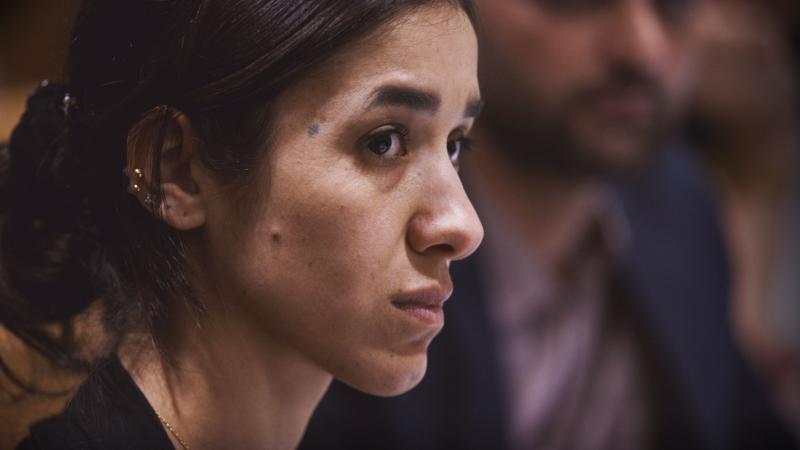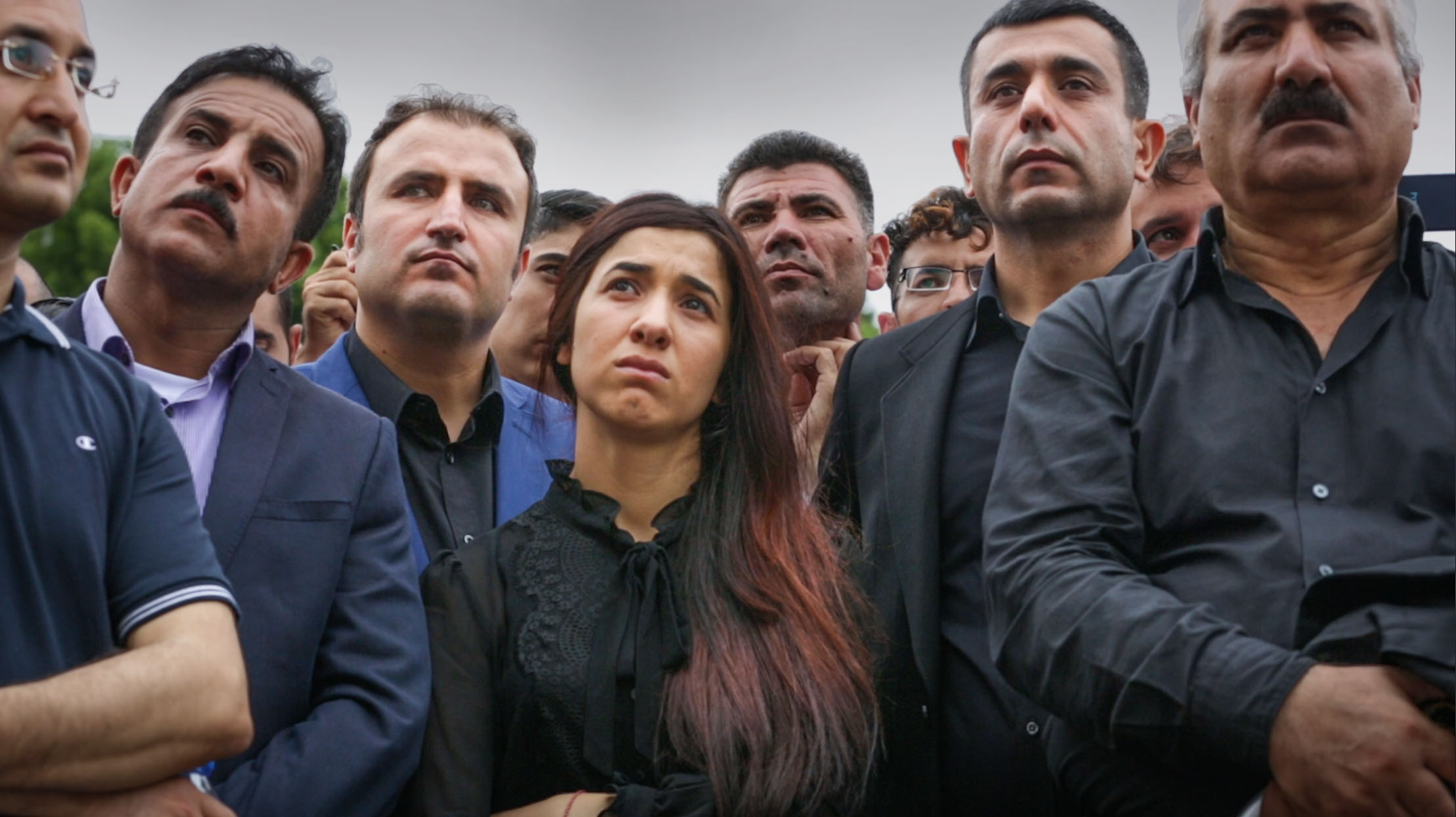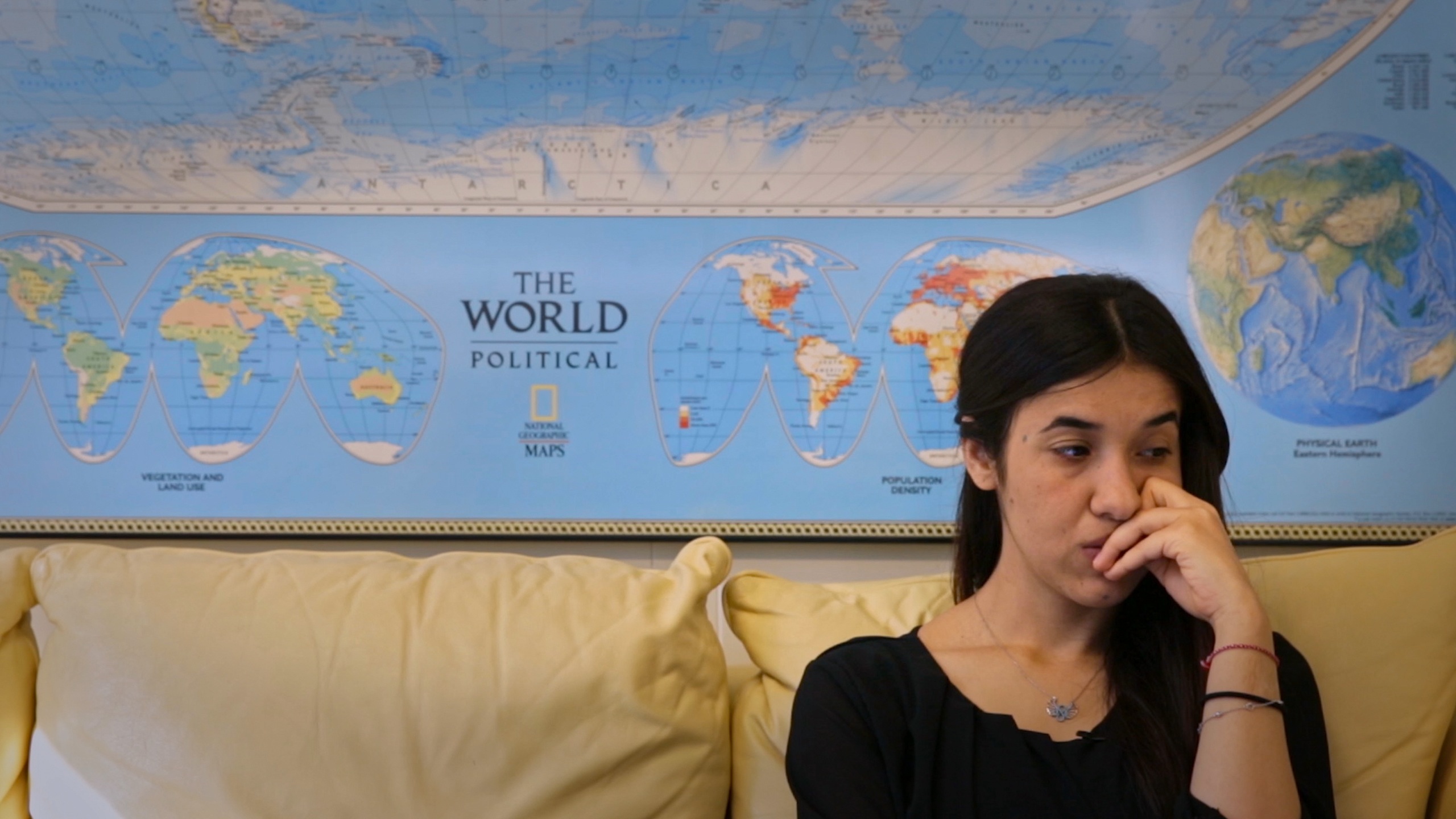Director Alexandria Bombach: 'I feel like a completely different person' | reviews, news & interviews
Director Alexandria Bombach: 'I feel like a completely different person'
Director Alexandria Bombach: 'I feel like a completely different person'
Director of On Her Shoulders on filming Yazidi campaigner Nadia Murad

Nadia Murad caught the world’s attention when she spoke at the United Nations Security Council. She spoke of living under ISIS, daily assaults, escaping, and the current plight of the Yazidi people, in refugee camps and still under ISIS control. It was a heart-breaking plea for support to the world’s silent nations.
On Her Shoulders is a new documentary about Nadia’s plight, and specifically the amount of travelling, planning and interviewing she subjects herself to just to keep the Yazidi in the news. From debuting director Alexandria Bombach, it’s an intensely personal and engrossing watch. Politicians offer dead-eye platitudes while she’s forced to relive her trauma. It’s a subtle but damning insight into the politics of international aid.
The film debuted at Sundance Film Festival in 2018, and is released in the UK this Friday. Bombach is currently in Britain filming her next feature, and spoke to The Arts Desk about what she learned from her time with Nadia.
OWEN RICHARDS: When did you first become aware of Nadia Murad?
ALEXANDRIA BOMBACH: I saw a video of her when she spoke at the UN Security Council for the first time in September 2015. It was such a powerful speech and testimony that it really got under my skin, I couldn’t stop thinking about it. I remember seeing the news was covering the beginning of the genocide in August 2014, and I was very moved by it. It wasn’t until July 2016 that I actually was asked by Riot Film Productions to make a short film about Nadia. I went and shot like crazy, and it turned into a feature. What was your first contact with her like?
What was your first contact with her like?
I had never filmed anyone with this level of experience of trauma before, so I was very cautious and tried to prepare as much as I could for that. Nadia’s very used to media, but documentary is a different type of storytelling, so in our initial meeting I was just explaining that I would be around all the time. The team had already given permission to film, but I wanted to sit and ask her again. I really expected a longer conversation but she agreed right away and didn’t seem fazed by it. That was just a sign of how desperate the campaign was at that point for anyone to pay attention. It was part of Nadia’s push to get everyone’s eyes and ears on this, as much as she possibly could. It was less about my attention than anybody’s she could.
How did your relationship develop from her just using this as a way to spread her message?
We were in very close quarters for almost three months. Of course, we got to know her pretty well, but this was someone who from very early in the morning to very late at night was so busy. From meetings to testimonies to interviews - a constant barrage of people trying to get this story out there. It was exhausting work for her, so I really did try to give her as much space as possible, even if we were in close quarters. What was it like becoming part of that world?
What was it like becoming part of that world?
It was a difficult film to shoot because of the context of her story, but also because I didn’t want to just be another person that was just taking from her. That’s a good reason why the film is edited and made the way it is, and talks about the things that it does. This was my first time witnessing an advocacy campaign behind the scenes, trying to get the world to care about a genocide. It was my first time seeing these kinds of meetings and watching another storyteller or journalist interview someone who has been through this kind of trauma. Also, my first time seeing behind the scenes of the UN, so it was difficult to not recognise as a part of that same world she was having to deal with. It was difficult to ask her every day to put the mic on and participate in this because I knew she was already handling so much.
The film gives a rare insight into how institutions like the UN work. Did you learn anything from seeing that from her point of view?
Completely. Not only how it works, but I feel like a completely different person. Being with these people taught me a lot about injustice and the problematic ways in how we tell these stories. It was a real eye-opener on advocacy and empathy in general.
There are times when Nadia is with these smiling politicians that are quite surreal. Did you sense that awkwardness there in the room when filming?
Oh definitely. With any kind of film I’m making, I try to pay attention to how I felt in the moment. That’s why they’re in the film because they stood out to me when I was there. A big part of the decision process for the edit was not necessarily trying to get the audience to understand how Nadia feels, because I think that would be disingenuous because we can’t really understand that. She’s been through such horrific things and has such a unique experience, it’s difficult for anybody to understand what she’s going through.
In the edit, I was really focusing on how I was feeling in those moments, witnessing this from a very close proximity but removed in the same way. Just observe what she was going through, and that’s the tent poles of the film – these odd observations of what Nadia has to go through to get the world to listen.
The sound design of the film gives scenes a real dreamlike quality. Did you have any particular influences when you were putting that edit together?
I should say my additional editor Michael Bucuzzo and sound editor Lawrence Everson were crucial partners in that sound design. It was so critical to all of us, and even my composer Patrick Jonsson, to respect silence and use that as a tool. Have these juxtapositions of sound and silence that can reinforce the juxtaposition of her life chaos and inner thoughts. For me, The Look of Silence was a huge influence on me, as was Fire at Sea. I don’t know if I can articulate why, but I watched those films many times while I was making this film. Did you have a clear idea of how the documentary would look ahead of filming?
Did you have a clear idea of how the documentary would look ahead of filming?
I didn’t know how it was going to look, but I had seen so many interviews of Nadia done by the news media that I didn’t want to do the same kind of interview set-up shot, with her in two-thirds of the frame. It was a little bit intimidating because I’d never done this process, but it was important to me to do the interview with her looking directly into the lens, directly at the audience.
There’s so much that audiences today ingest about the refugee crisis and there’s lots of apathy building toward these kinds of issues, allowing a separation from them. I wanted this film to be confronting. Not let you look away, so in a literal sense I’m having Nadia look directly at the audience, and I decided to stay pretty close to her with the lens for most of the shots. I wanted people to feel physically close to her.
Nadia always says she wants to move attention away from herself and onto refugees and the women still living under ISIS, but it’s a very personal film. How did she feel about being that lead subject?
She saw the film a few months before Sundance, and I think she was pretty blown away by it. She was surprised, because a lot of the media she’s seen on herself is about her captivity. She told me she was really happy the film is called On Her Shoulders instead of being called “Nadia”. She recognised the power of telling a story about the work, showing something different, and to get people to face what’s not being done. Showing what Nadia and her people have to do versus just focusing on the experience that she survived. She really appreciated that side of it.
Have members of the Yazidi community seen the film?
Every now and then I’ll be at a screening, and have Yazidi people there, and the films available on iTunes in the United States now, so more and more are seeing the film. The reaction as been nothing but positive, and I’m really thankful for that because it’s dedicated to the Yazidi people. It was really important for me to show them as much respect as possible and so far it’s been a very positive response.
You’re in the UK currently filming your next project. What’s that about?
I’m making a film about a band. They’re not crazy popular in Europe, they’re called The Indigo Girls, and they’re doing their next album at Real World studios in London. They’re really big in the States but not so big over here. This is my first shoot with them. All of 2018 I was on the road for On Her Shoulders, and I’m doing the last bits of interviews and release stuff for that now. Then I can move on to a happier film. But it’s a very privileged thing for me to say, because Nadia and her work has completely ramped up and this is going to be much of her life.
Explore topics
Share this article
The future of Arts Journalism
You can stop theartsdesk.com closing!
We urgently need financing to survive. Our fundraising drive has thus far raised £49,000 but we need to reach £100,000 or we will be forced to close. Please contribute here: https://gofund.me/c3f6033d
And if you can forward this information to anyone who might assist, we’d be grateful.

Subscribe to theartsdesk.com
Thank you for continuing to read our work on theartsdesk.com. For unlimited access to every article in its entirety, including our archive of more than 15,000 pieces, we're asking for £5 per month or £40 per year. We feel it's a very good deal, and hope you do too.
To take a subscription now simply click here.
And if you're looking for that extra gift for a friend or family member, why not treat them to a theartsdesk.com gift subscription?
more Film
 Blu-ray: The Sons of Great Bear
DEFA's first 'Red Western': a revisionist take on colonial expansion
Blu-ray: The Sons of Great Bear
DEFA's first 'Red Western': a revisionist take on colonial expansion
 Spinal Tap II: The End Continues review - comedy rock band fails to revive past glories
Belated satirical sequel runs out of gas
Spinal Tap II: The End Continues review - comedy rock band fails to revive past glories
Belated satirical sequel runs out of gas
 Downton Abbey: The Grand Finale review - an attemptedly elegiac final chapter haunted by its past
Noel Coward is a welcome visitor to the insular world of the hit series
Downton Abbey: The Grand Finale review - an attemptedly elegiac final chapter haunted by its past
Noel Coward is a welcome visitor to the insular world of the hit series
 Islands review - sunshine noir serves an ace
Sam Riley is the holiday resort tennis pro in over his head
Islands review - sunshine noir serves an ace
Sam Riley is the holiday resort tennis pro in over his head
 theartsdesk Q&A: actor Sam Riley on playing a washed-up loner in the thriller 'Islands'
The actor discusses his love of self-destructive characters and the problem with fame
theartsdesk Q&A: actor Sam Riley on playing a washed-up loner in the thriller 'Islands'
The actor discusses his love of self-destructive characters and the problem with fame
 Honey Don’t! review - film noir in the bright sun
A Coen brother with a blood-simple gumshoe caper
Honey Don’t! review - film noir in the bright sun
A Coen brother with a blood-simple gumshoe caper
 The Courageous review - Ophélia Kolb excels as a single mother on the edge
Jasmin Gordon's directorial debut features strong performances but leaves too much unexplained
The Courageous review - Ophélia Kolb excels as a single mother on the edge
Jasmin Gordon's directorial debut features strong performances but leaves too much unexplained
 Blu-ray: The Graduate
Post #MeToo, can Mike Nichols' second feature still lay claim to Classic Film status?
Blu-ray: The Graduate
Post #MeToo, can Mike Nichols' second feature still lay claim to Classic Film status?
 Little Trouble Girls review - masterful debut breathes new life into a girl's sexual awakening
Urska Dukic's study of a confused Catholic teenager is exquisitely realised
Little Trouble Girls review - masterful debut breathes new life into a girl's sexual awakening
Urska Dukic's study of a confused Catholic teenager is exquisitely realised
 Young Mothers review - the Dardennes explore teenage motherhood in compelling drama
Life after birth: five young mothers in Liège struggle to provide for their babies
Young Mothers review - the Dardennes explore teenage motherhood in compelling drama
Life after birth: five young mothers in Liège struggle to provide for their babies
 Blu-ray: Finis Terrae
Bleak but compelling semi-documentary, filmed on location in Brittany
Blu-ray: Finis Terrae
Bleak but compelling semi-documentary, filmed on location in Brittany
 Oslo Stories Trilogy: Sex review - sexual identity slips, hurts and heals
A quietly visionary series concludes with two chimney sweeps' awkward sexual liberation
Oslo Stories Trilogy: Sex review - sexual identity slips, hurts and heals
A quietly visionary series concludes with two chimney sweeps' awkward sexual liberation

Add comment